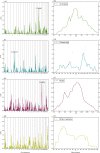Creative Activities in Music--A Genome-Wide Linkage Analysis
- PMID: 26909693
- PMCID: PMC4766096
- DOI: 10.1371/journal.pone.0148679
Creative Activities in Music--A Genome-Wide Linkage Analysis
Abstract
Creative activities in music represent a complex cognitive function of the human brain, whose biological basis is largely unknown. In order to elucidate the biological background of creative activities in music we performed genome-wide linkage and linkage disequilibrium (LD) scans in musically experienced individuals characterised for self-reported composing, arranging and non-music related creativity. The participants consisted of 474 individuals from 79 families, and 103 sporadic individuals. We found promising evidence for linkage at 16p12.1-q12.1 for arranging (LOD 2.75, 120 cases), 4q22.1 for composing (LOD 2.15, 103 cases) and Xp11.23 for non-music related creativity (LOD 2.50, 259 cases). Surprisingly, statistically significant evidence for linkage was found for the opposite phenotype of creative activity in music (neither composing nor arranging; NCNA) at 18q21 (LOD 3.09, 149 cases), which contains cadherin genes like CDH7 and CDH19. The locus at 4q22.1 overlaps the previously identified region of musical aptitude, music perception and performance giving further support for this region as a candidate region for broad range of music-related traits. The other regions at 18q21 and 16p12.1-q12.1 are also adjacent to the previously identified loci with musical aptitude. Pathway analysis of the genes suggestively associated with composing suggested an overrepresentation of the cerebellar long-term depression pathway (LTD), which is a cellular model for synaptic plasticity. The LTD also includes cadherins and AMPA receptors, whose component GSG1L was linked to arranging. These results suggest that molecular pathways linked to memory and learning via LTD affect music-related creative behaviour. Musical creativity is a complex phenotype where a common background with musicality and intelligence has been proposed. Here, we implicate genetic regions affecting music-related creative behaviour, which also include genes with neuropsychiatric associations. We also propose a common genetic background for music-related creative behaviour and musical abilities at chromosome 4.
Conflict of interest statement
Figures




References
-
- Guilford JP. Creativity. Am Psychol. 1950; 5:444–454. - PubMed
-
- Csikszentmihalyi M. Flow: the psychology of optimal experience 1st ed. New York: Harper & Row; 1990.
MeSH terms
Grants and funding
LinkOut - more resources
Full Text Sources
Other Literature Sources
Research Materials

